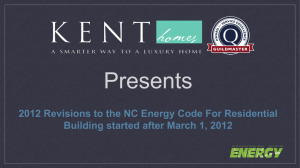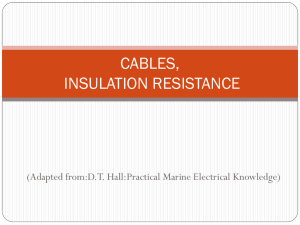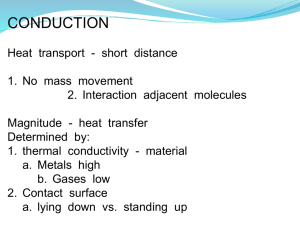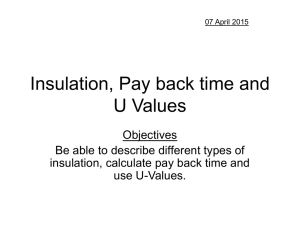Recommendations of the Governance Task Force
advertisement
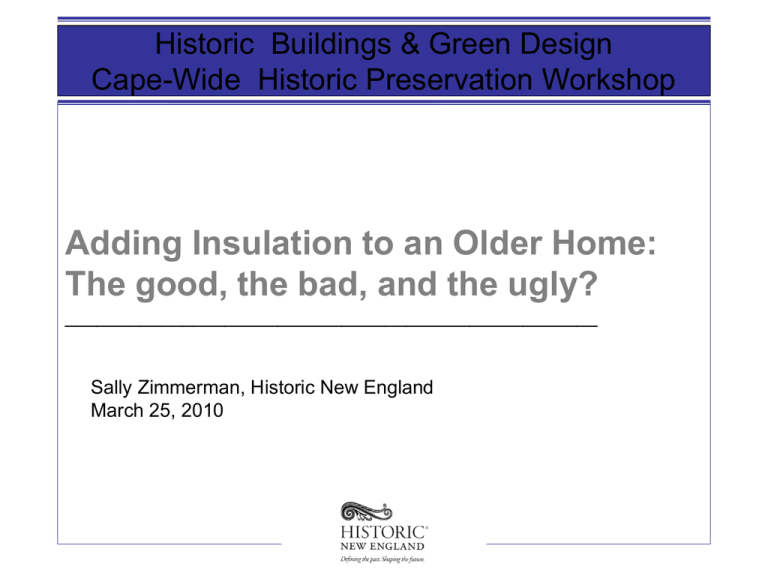
Historic Buildings & Green Design Cape-Wide Historic Preservation Workshop Adding Insulation to an Older Home: The good, the bad, and the ugly? __________________________________________________ Sally Zimmerman, Historic New England March 25, 2010 There’s always breaking news on the energy front . . . and emerging news on green impacts and preservation www.energycircle.com, March 6, 2010 New York Times, March 18, 2010 What you need to know before you insulate an older home • What is most often recommended (and how these recommendations are changing) • Why these may not be right for the older or historic home • What you can do to upgrade for energy savings in an older or historic home – appropriately! A “green” house glossary Deep energy retrofit Super-insulation Insulating the interior or exterior to far exceed current building and energy codes Net zero A net zero, or zero energy, structure in general is one that generates more energy than it uses; it can be, but usually is not, disconnected from the power grid. Strictly defined, net zero structures generate no carbon emissions Super-insulation, plus the addition of renewable energy sources or other measures to further reduce the carbon footprint (passive and active solar systems, geothermal, wind power, water use reduction, landscaping) Passive home A passive home is so tightly constructed that it needs no heating or cooling source HERS Index: Home Energy Rating System • Set by Residential Energy Services Network (RESNET) • Scoring system scaled from 0 - 200 • Zero net energy home = 0 • “Reference” new home = 100 • Most older homes = well over 100 • Each 1 point decrease in HERS = 1% reduction in energy consumed HERS measures: -Building Enclosure -Mechanical Systems -Lighting/Appliances -Renewable Energy Massachusetts: acting to reduce energy use ahead of federal changes • • • • • First major step towards Zero Net Energy Buildings: amend the State Building Code Massachusetts adopted the International Energy Conservation Code (IECC) 2009 as its new state building code, effective January 1, 2010 Increases energy efficiency requirements by 10% over the current base code ZNEB establishes regulatory and financial incentives for deepenergy retrofits Directs utilities to pilot 250 deepenergy retrofits in existing homes Stretch code: local option allows more stringent energy standard that “stretches” the base code requirements • Residential alterations & renovations can meet stretch code by – Prescriptive path – Performance path • • Prescriptive meets: Energy Star for Homes requirement (HERS 80) Performance meets: HERS of 80 (houses over 2000 sf) • HERS of 85 (houses less than 2000 sf) HERS case study for stretch code: Cambridge MA triple-decker, 2009 • • • • • • • • Existing = vinyl replacement windows , R-10 ceiling insulation; 11 ACH @ 50 Pascals pressure; no mechanical ventilation Initial HERS rating = 143 Retrofitted with R-13 wall insulation, R-30 ceiling insulation, air sealed to 5 ACH @ 50 Pascals, bath fans added Improvement cost = $14,847 Improved HERS = 85 With 3 new gas boilers @ 86% AFUE Upgraded cost = $29,395 Upgraded HERS = 80 http://www.cambridgema.gov/~CDD/et /stretchcode/index.html What is recommended generally (in the rest of the US) Oak Ridge National Laboratory: “Insulation Recommendations for Existing Wood-Framed Houses” Most energy interventions assume your house looks like this . . . but what if your house looks like this? Traditional active and passive interventions support energy efficiency in an old house Traditional practices and design provide the starting point for energy savings Passive and active energy measures are: - Economical - Reversible - Work with the historic structure and materials George Nash, Renovating Old Houses Preservation concerns in insulating older and historic houses . . . 1. We don’t know how these materials and techniques will respond over time (we need more materials science research) 2. It’s complex: contractors are unlikely to know how to properly install them (we need standards for training weatherization contractors on old houses) Boston Globe, January 18, 2009 “Arlington house may blaze new trail in energy conservation” 3. It’s expensive to do it right (so how many people will be able to afford to retrofit “right”?) Super-insulation/deep energy retrofits of old houses require careful planning and affect historic materials and finishes Save energy costs and reduce consumption in an older home without losing historic material and character KISSS: Keep it simple, start small •Air Seal -Energy audits using a blower door test show areas of air leakage -Caulk inside and out to close gaps and stop air movement -Weatherstrip windows and doors •Insulate Attics -Seal areas of air infiltration -Add loose fill or batt insulation •Seal and Insulate Ducts •Insulate Hot Water Heaters and Pipes . . . and REPAIR your wood windows! Air Infiltration: Blower door test diagnoses sources Infrared camera monitors locations of heat loss Comprehensively seal sources of air infiltration by caulking gaps Exterior: Use modified silicone polymer or backer rod and expanding polyurethane foam (foam must be painted to resist weather) Interior: Use water-based latex Insulate attics with fiberglass or other batting, or loose-fill insulation; air seal gaps before installing insulation George Nash, Renovating Old Houses Seal and insulate ducts; insulate hot water pipes High efficiency appliances But what about insulating walls? The big question for old house owners • • • Wall insulation is often recommended for energy retrofits in existing houses Adding insulation to exterior wall cavities is difficult unless the walls are open When walls are insulated, comprehensive measures to air seal, provide proper moisture barriers, and adequately ventilate interior air must also be taken www.highcountryconservation.org Wall insulation: not right for all houses • Sprayed in place open or closed cell foam insulation: – Provides superior insulation – Comprehensive air sealing and – Good moisture control BUT it also: – Requires removal of interior finishes and plaster and whole house ventilation – Obscures historic fabric – Is not reversible Blown-in cellulose: the jury is still out on this . . . Rely on Department of Energy/Oak Ridge National Laboratory web sites for information DOE and ORNL advise: -adding insulation to an old house is complex and difficult -older wiring in walls retrofitted with insulation can be a fire hazard -potential moisture problems must be mitigated through 1) excluding water entry, 2) ventilating interior moisture, 3) stopping air leaks, and 4) providing proper attic ventilation -More data would help a lot! The preservationist’s nightmare Proactive approaches to balancing preservation and energy goals Tailor interventions to age, building type, or significance? Older houses (1870-1950) - Use “modern” dimensional lumber, balloon/platform framing - Originally included central heating systems - Often built with stock millwork, trim, architectural elements Should be able to accept wall insulation without serious loss of integrity Avoid “energy improvement experiments” on the oldest and most significant properties “Historic” houses (1680-1850) - Use pre-industrial timber or Eastern braced framing - Not constructed with central heating systems OR Very significant or rare houses May not be suitable for wall insulation energy retrofits at all Insulation Interventions for Older and Historic Houses To summarize: • Keep it simple, start small – – – – Air Seal Insulate Attics Seal and Insulate Ducts Insulate Hot Water Pipes • Extensive energy retrofits are costly, complex, and potentially destructive of historic character and materials • Be wary of wall insulation • Consider information sources carefully With care and common sense, every old house can be GREEN!


